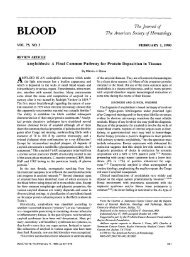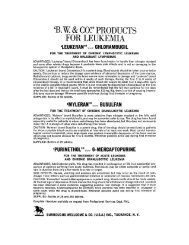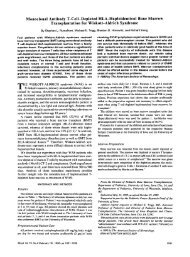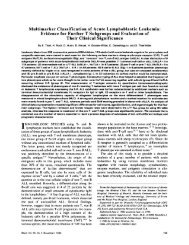Platelet Life Span in Normal, Splenectomized and ... - Blood
Platelet Life Span in Normal, Splenectomized and ... - Blood
Platelet Life Span in Normal, Splenectomized and ... - Blood
Create successful ePaper yourself
Turn your PDF publications into a flip-book with our unique Google optimized e-Paper software.
From www.bloodjournal.org by guest on April 28, 2015. For personal use only.<br />
PLATELET LIFE SPAN IN RATS 47<br />
_____________________________<br />
TABLE 1 -Results of 1 03 Consecutive Isolations ofPiateletsfroni Rat <strong>Blood</strong><br />
Average<br />
Range<br />
- Yield of platelets %: 70 50-91<br />
Contam<strong>in</strong>ation with red cells ( No.<br />
of red cells per 100,000 platelets ) : 1.2 0-14<br />
Contam<strong>in</strong>ation with white cells ( No.<br />
of white cells per 100,000 platelets ) : 0.9 0-4<br />
blood was added, the sample was dried at room temperature anti counted <strong>in</strong> an endw<strong>in</strong>tlow<br />
Greiger Mueller counter. A total of 4096 counts was cOIlll)ik-tl for each saiiiple.<br />
The background radioactivity was 24 to 26 counts per m<strong>in</strong>ute. Twenty-four hours after the<br />
<strong>in</strong>jection of DFP, the platelet samples gave 72 to 170 net counts per m<strong>in</strong>ute. The radioactivity<br />
was related to the total number of <strong>Platelet</strong>s <strong>in</strong> the comb<strong>in</strong>ed supernatants. No<br />
correction was made for the contam<strong>in</strong>ation with red anti white cells, s<strong>in</strong>ce on an average<br />
there was only one retl cell anti one white cell per 100,000 platelets ( see table 1 ).<br />
RESULTS<br />
<strong>Platelet</strong> life span <strong>in</strong> normal (111(1 splenectonhize(l rats-Thirty-six rats were<br />
used, one-half of which were splenectomized <strong>and</strong> the other half shamoperated.<br />
The rats were operated upon 14 days prior to the <strong>in</strong>jection of<br />
DFp:12. At <strong>in</strong>tervals after the <strong>in</strong>jection of DFP3, two rats were killed <strong>in</strong> each<br />
group, <strong>and</strong> the radioactivity of the platelets was measured.<br />
The number of platelets <strong>in</strong> whole blood was slightly, but significantly,<br />
higher (0.025 < P < 0.05) <strong>in</strong> the splenectomized group: 1,286,000 platelets<br />
per cu.mm. ( 1,032,000 to 1,590,000 ) as compared to 1,191,000 ( 1,031,000 to<br />
1,329,000 ) <strong>in</strong> the normal group.<br />
The platelet radioactivity decreased from day to day <strong>in</strong> both groups. The<br />
po<strong>in</strong>ts fit an exponential curve better than a straight l<strong>in</strong>e ( fig. 1 ) . In this<br />
diagram each po<strong>in</strong>t corresponds to one rat. In figure 2, each po<strong>in</strong>t represents<br />
the average of a pair of rats, <strong>and</strong> the two l<strong>in</strong>es are fitted by the method of<br />
least squares. There is no significant difference between the slopes of these<br />
two l<strong>in</strong>es ( P = 0.65 ) , suggest<strong>in</strong>g that the platelet life span is essentially<br />
the same <strong>in</strong> both groups.<br />
<strong>Platelet</strong> life s-pan <strong>in</strong> normal <strong>and</strong> hyperspienic rats-Forty rats were used;<br />
one-half was made hypersplenic, <strong>and</strong> the other was untreated. At the time<br />
of sacrifice the weight was similar <strong>in</strong> both groups, b:it the spleens were on an<br />
average six times heavier <strong>in</strong> the hypersplenic group: 4.42 Gm. ( 3.15 to 6.31<br />
Gm. ) versus 0.69 Gm. ( 0.46 to 0.93 Gm. ) . The hypersplenic rats were<br />
anemic; their average hematocrit was 37.7 ( 33.0 to 42.0) versus 45.9 ( 43.8<br />
to 50.0 ) <strong>in</strong> the normal group. They also had a slight, but significant ( P <<br />
0.01 ) thrombocytopenia : 780,000 platelets per cu.mm. ( 542,000 to 1,046,000)<br />
compared to 966,000 ( 721,000 to 1,144,000) <strong>in</strong> the normal group.<br />
Both groups were <strong>in</strong>jected with DFP:12 at the same time, <strong>and</strong> two rats <strong>in</strong><br />
group were killed at <strong>in</strong>tervals after the <strong>in</strong>jection. Figure 3 gives the<br />
I)lttelet radioactivity of the hvo groups. The data are plotted as <strong>in</strong> figure 2.<br />
each po<strong>in</strong>t is the average of two rats, <strong>and</strong> the l<strong>in</strong>es are fitted by the method<br />
of least squares. Aga<strong>in</strong>, there is no significant difference <strong>in</strong> the slope of













